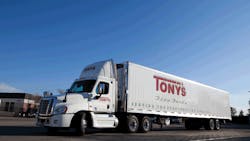As chief information officer for Tony's Fine Foods, Mark Geery's job is to spot the next important initiative in food channel logistics. Linking the enabling technology together is also his responsibility.
Tony's is a perishable food distributor on the West Coast. It delivers to grocery stores and specialty stores. Many of the products are frozen and chilled and require special handling throughout storage and delivery to keep them and their consumers safe.
See Also: Manufacturing & Distribution Center Best Practices
Tony's sources from 1,300 vendors around the world and uses sophisticated demand forecasting tools to determine demand based on seasonality, grocery store ads and historical data. It relies on several sources of data, ranging from faxed and phoned customer orders to sales people using handhelds and laptops.
Once the orders are brought into the system, they are allocated for truck routing then sent to the warehouse, where they are picked by associates using voice technology. Orders are palletized, loaded onto trucks and invoiced.
The data is sent to a hosted business application (Airclic) which sends invoices electronically to the drivers' handhelds. The drivers inspect their truckload, scanning pallets to make sure they have the right orders before they close the trailer.
At each stop the driver scans products to match the invoice. The "Food Perform" cloud-based mobile app knows how many boxes the driver should have for the stop, and as he scans, the system tracks order fulfillment. If he should scan an item that's destined for another store, the system will warn him.
Upon completion the store associate will review the electronic invoice and sign it. That electronic signature is transmitted back to Tony's host system, along with any adjustments that need to be made. The driver will also be instructed to process any returns from that store, applying a label and scanning it to document what he's bringing back. Any damages are also documented.
The system will also instruct the driver to pick up products along the route back where, upon return to Tony's, they'll be received into inventory.
According to Geery, this electronic system has cut the costs of paperwork dramatically and improved tracking and tracing.
"Accounting needs to hang onto those proofs of delivery for seven years and with paper you have to store them in a file cabinet or send them somewhere to scan them," he says. "Printing two-part invoices is expensive and the printers are expensive to maintain. Plus, we would get calls from customers saying they're missing a product and we had no idea what caused that. The fact we're scanning each box now as we're giving it to them, we have an idea of when the box made it to the store. Many of those customer calls about a short after the delivery have gone away."
Tony's WMS tracks the P.O.s and knows when pallets are taken to the pick location, when products are picked and which stores went out each night.
"The hardest part with traceability is the sheer amount of touching and documenting," Geery says. "Any time there's a recall, the more you've documented the more precise you can be. There are two or three recalls a year, and each time we get better with the turnaround and at finding where to improve it."
He estimates a savings of $45,000 a year from going away from printing multi-part forms. The cost of a missed delivery is about $75, factoring in the need to credit the customer, re-order the product, pick it again and redeliver it. Geery says he saw a 30% improvement with scanning.
"The fact we were avoiding 30 missed deliveries a week resulted in an annual savings of $117,000," he adds. "Also, we were storing all those images, and we were spending $70,000 a year on imaging. We didn't get away from all of that but it's a fraction of the cost just storing the signature itself."
Of course there's also an inestimable savings, factoring in the cost of a missed delivery that causes a customer to walk away.
About the Author
Tom Andel
Editor-in-Chief
Tom Andel is an award-winning editorial content creator and manager with more than 35 years of industry experience. His writing spans several industrial disciplines, including power transmission, industrial controls, material handling & logistics, and supply chain management.
